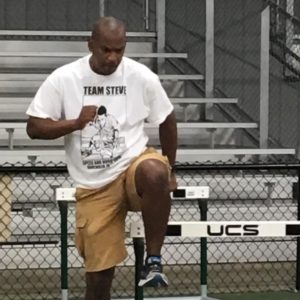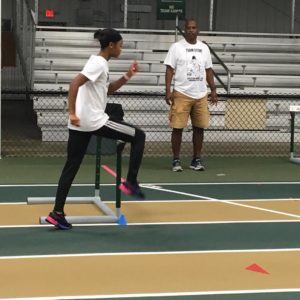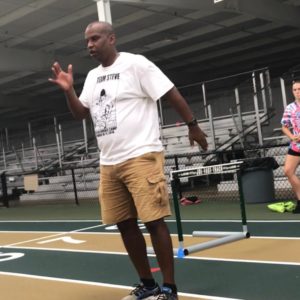Team Steve Coaches Clinic
by Steve McGill
On October 13, 2018, Coach Hector Cotto and I held the first-ever Team Steve Hurdle Coaches’ Clinic. The clinic took place at the same venue where we held two of our camps for athletes last year, and where we will be holding another camp on November 10-11 of this year — the JDL Fast Track in Winston Salem, NC. The clinic was attended by 16 coaches, most of whom were from out of state. We had coaches come from such faraway places as Utah, Chicago, Canada, and Kentucky. I had a great time interacting with all of the coaches, and I really enjoyed sharing some of the methods that have made me successful in my 24-year career coaching hurdlers.
[am4show not_have=’g5;’]
[/am4show][am4guest]
[/am4guest][am4show have=’g5;’]
As I explained to the coaches, I don’t claim to know everything, but I do know what works for me. Over the years, I have coached just about every hurdling style that exists, and in recent years I have honed in on the specific methods that have proven most beneficial on a most consistent basis. I’m at a point in my career where I can say, “I know this works,” whether I’m talking about arm positioning, lead leg mechanics, trail leg mechanics, the forward lean, etc.
One of the points I emphasized to the coaches is that hurdling is an art form. When I interviewed Renaldo Nehemiah for this website many years ago, that was something he emphasized — the importance of mastering the art form. Yet, as Nehemiah made clear through his career, and as I have, in my own way, have made clear through mine, focusing on hurdling as an art form as opposed to focusing on hurdling as a foot race does not mean being unconcerned about winning. Quite the contrary. My point would be that the more you master the art form, the more you increase your chances of winning. So, the purpose of mastering the art form is to win as many races as possible.
For most of the morning session of the clinic, I took the coaches through the gamut of drills that I have my hurdlers do, starting with a beginner’s first day. The drills I use are the following, in the following order:
A Marches
A Skips
High Knees
Side Walk-overs for Trail Leg
Side Walk-overs for Lead Leg
Fence Drill
Marching Pop-overs
Cycle Drill
Quickstep Drill
From there, Coach Cotto took over and instructed the coaches on falling starts, three-point starts, four-point starts, and block starts.
For all of the drills and the starts, we had two of my athletes on hand to demonstrate. One — Falon Spearman — is a girl I’ve talked about often on this website. She finished first last summer in the 14-year-old girls 100m hurdles at USATF Junior Olympic Nationals. The other athlete was Jenna Green — a high school sophomore from Maryland who has traveled down to North Carolina about six times over the past two years to train with me, and has also attended two of the past Team Steve hurdle camps.
In the afternoon session, we started with a discussion of stride pattern in the long hurdles. Then I had Falon and Jenna demonstrate some drills for learning to alternate lead legs in the long hurdles. From there, we discussed hurdling on the curve, and had Falon and Jenna demonstrate curve hurdling drills. Then we went back to the classroom, where I went over workout plan ideas for sprint hurdlers, long hurdlers, and double hurdlers for each part of the season. Coach Cotto then went over strength training, and I closed by talking about how to communicate with your hurdlers, depending on the maturity level and experience level of the athlete.
So we crammed a lot of information into seven hours.
In the above photo, I am demonstrating one of the most fundamental aspects of hurdling that all hurdlers must learn from day one: lead with the knee. Not only lead with the knee, but drive forward with the knee, attack the hurdle with the knee. I’m also demonstrating the importance of raising the heel up under the hamstring. If the heel gets out in front too soon, it’ll take away space to clear the obstacle. Knee up, heel up.
In the above photo, Coach Cotto explains to the coaches elements of the block start. One of the things he mentioned is that the ankles should be dorsi-flexed in the pedals in set position. Doing so, he explained, eliminates the slight rocking back that occurs among most sprinters and hurdlers when they first push off the pedals.
In the above photo, I watch as Falon Spearman demonstrates the side walk-over drill for trail leg. As I mentioned to the coaches, the side walk-over drills are the “training wheels” for hurdlers. In these drills, there is always one foot on the ground at all times, so it’s safe and it gives the athlete plenty of time to learn the proper movements while making the movements. I only use walk-over drills for beginners, as they don’t mimic what real hurdling is like. Their purpose, as I see it, is to teach the beginner what each leg is supposed to do. I see no point in doing walk-overs for athletes who have moved beyond the beginning stages of their development. And, as I explained to the coaches, I never have my athletes do walk-overs over the top, as it teaches a timing of the lean that does not match the timing of the lean in real hurdling. In real hurdling, you lean as soon as you take off. In over-the-top walk-overs, you lean after the lead leg touches down.
In the above photo, I’m showing the coaches the arm action I like for my hurdlers to use. I teach that the arms should stay in sprint position when the athlete is clearing the hurdle. No twisting the wrist, no “looking at the watch,” etc.
In the above video, Jenna Green demonstrates the trail leg wall drill, Team Steve style: a big push off the back leg, raise the knee and heel up immediately after push-off, then drive the knee to the front, keeping it high. Not until the knee is facing the front does the foot attack the track. We only open the groin as much as we have to in order to avoid contact with the barrier. We want the trail leg to function as closely to a lead leg as possible.
In the above video, Falon Spearman demonstrates the marching popover drill. Falon, who never messes up, clipped the first hurdle with her trail leg on her first attempt, which inadvertently provided me with a teachable moment. As she tried to recover and keep going, I told her to go back and start over. I also explained to the coaches that if something like that happens, it’s best to just start the rep over. That advice only applies to drills like this one. In drills that require more speed, and whenever doing block starts, you want to run through your mistakes and recover on the fly.
I was a bit nervous about doing a clinic, since I had never done one before, but it went really well. I’m happy to share all that I’ve learned over the years, and I do feel good about the possibility that other coaches will be influenced by my teachings, and will pass them on.
[/am4show]




